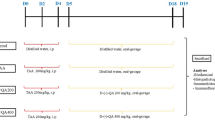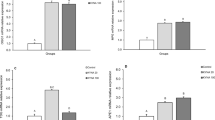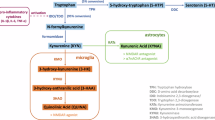Abstract
Aim:
To assess whether systemic delivery of kynurenic acid improves the outcomes of heatstroke in rats.
Methods:
Anesthetized rats were divided into 2 major groups and given vehicle solution (isotonic saline 0.3 mL/kg rat weight) or kynurenic acid (30–100 mg in 0.3 mL saline/kg) 4 h before the start of thermal experiments. They were exposed to an ambient temperature of 43 °C for 68 min to induce heatstroke. Another group of rats were exposed to room temperature (26 °C) and used as normothermic controls. Their core temperatures, mean arterial pressures, serum levels of systemic inflammatory response molecules, hypothalamic values of apoptotic cells and neuronal damage scores, and spleen, liver, kidney and lung values of apoptotic cells were determined.
Results:
The survival time values during heatstroke for vehicle-treated rats were decreased from the control values of 475–485 min to new values of 83–95 min. Treatment with KYNA (30–100 mg/kg, iv) 4 h before the start of heat stress significantly and dose-dependently decreased the survival time to new values of 152–356 min (P<0.05). Vehicle-treated heatstroke rats displayed hypotension, hypothalamic neuronal degeneration and apoptosis, increased serum levels of tunor necrosis factor-α (TNF-α), intercellular adhesion molecule-1 (ICAM-1), and interleukin-10 (IL-10), and spleen, liver, kidney, and lung apoptosis. KYNA preconditioning protected against hypotension but not hyperthermia and attenuated hypothalamic neuronal degeneration and apoptosis during heatstroke. KYNA preconditioning attenuated spleen, kidney, liver, and lung apoptosis and up-regulated serum IL-10 levels but down-regulated serum TNF-α and ICAM-1 levels during heatstroke.
Conclusion:
Our results suggest that systemic delivery of kynurenic acid may attenuate multiorgan dysfunction in rats after heatstroke.
Similar content being viewed by others
Log in or create a free account to read this content
Gain free access to this article, as well as selected content from this journal and more on nature.com
or
References
Bouchama A, Knochel JP . Heat stroke. N Engl J Med 2002; 346: 1978–88.
Chang CK, Chang CP, Chiu WT, Lin MT . Prevention and repair of circulatory shock and cerebral ischemia/injury by various agents in experimental heatstroke. Curr Med Chem 2006; 13: 3145–54.
Liu WS, Chen CT, Foo NH, Huang HR, Wang JJ, Chen SH, et al. Human umbilical cord blood cells protect against hypothalamic apoptosis and systemic inflammation response during heatstroke in rats. Pediatr Neonatol 2009; 50: 208–16.
Yang HH, Chang CP, Cheng JT, Lin MT . Inhibition of acute lung inflammation and injury is a target of brain cooling after heatstroke injury. J Trauma 2010; in press.
Nemeth H, Robotka H, Toldi J, Vecsei L . Kynurenines in the central nervous system: recent developments. Centr Nerv Sys Agents Med Chem 2007; 7: 45–56.
Salvati P, Ukmar G, Dho L, Rosa B, Cini M, Marconi M, et al. Brain concentrations of kynurenic acid after a systemic neuroprotective dose in the gerbil model of global ischemia. Prog Neuropsychopharmacol Biol Psychiatry 1999; 23: 741–52.
Wejksza K, Rzeski W, Turski WA . Kynurenic acid protects against the homocysteine-induced impairment of endothelial cells. Pharmacol Rep 2009; 61: 751–6.
Varga G, Erces D, Fazekas B, Fulop M, Kovacs T, Kaszaki J, et al. N-Methyl-D-aspartate receptor antagonism decreases motility and inflammatory activation in the early phase of acute experimental colitis in the rat. Neurogastroenterol Motil 2010; 22: 217–25.
Pulsinelli WA, Levy DE, Duffy TE . Regional cerebral blood flow and glucose metabolism following transient forebrain ischemia. Ann Neurol 1982; 11: 499–509.
Chen SH, Chang FM, Tsai YC, Huang KF, Lin MT . Resuscitation from experimental heatstroke by transplantation of human umbilical cord blood cells. Crit Care Med 2005; 33: 1377–83.
Chen SH, Chang FM, Tsai YC, Huang KF, Lin CL, Lin MT . Infusion of human umbilical cord blood cells protect against cerebral ischemia and damage during heatstroke in the rat. Exp Neurol 2006; 199: 67–76.
Hall DM, Buettner GR, Oberley LW, Xu L, Matthes RD, Gisolfi CV . Mechanisms of circulatory and intestinal barrier dysfunction during whole body hyperthermia. Am J Physiol Heart Circ Physiol 2001; 280: H509–21.
Dematte JE, O'Mara K, Buescher J, Whitney CG, Forsythe S, McNamee T, et al. Near-fatal heat stroke during the 1995 heat wave in Chicago. Ann Intern Med 1998; 129: 173–81.
Bynum GD, Pandolf KB, Schuette WH, Goldman RF, Lees DE, Whang-Peng J, et al. Induced hyperthermia in sedated humans and the concept of critical thermal maximum. Am J Physiol 1978; 235: R228–36.
Pettigrew RT, Galt JM, Ludgate CM, Horn DB, Smith AN . Circulatory and biochemical effects of whole body hyperthermia. Br J Surg 1974; 61: 727–30.
Chatterjee S, Premachandran S, Bagewadikar RS, Bhattacharya S, Chattopadhyay S, Poduval TB . Arginine metabolic pathways determine its therapeutic benefit in experimental heatstroke: role of Th1/Th2 cytokine balance. Nitric Oxide 2006; 15: 408–16.
Shen KH, Lin CH, Chang HK, Chen WC, Chen SH . Premarin can act via estrogen receptors to rescue mice from heatstroke-induced lethality. Shock 2008; 30: 668–74.
Birch PJ, Grossman CJ, Hayes AG . Kynurenic acid antagonises responses to NMDA via an action at the strychnine-insensitive glycine receptor. Eur J Pharmacol 1988; 154: 85–7.
Hilmas C, Pereira EF, Alkondon M, Rassoulpour A, Schwarcz R, Albuquerque EX . The brain metabolite kynurenic acid inhibits alpha7 nicotinic receptor activity and increases non-alpha7 nicotinic receptor expression: physiopathological implications. J Neurosci 2001; 21: 7463–73.
Wang J, Simonavicius N, Wu X, Swaminath G, Reagan J, Tian H, et al. Kynurenic acid as a ligand for orphan G protein-coupled receptor GPR35. J Biol Chem 2006; 281: 22021–8.
Hou ST, MacManus JP . Molecular mechanisms of cerebral ischemia-induced neuronal death. Int Rev Cytol 2002; 221: 93–148.
Coyle JT, Puttfarcken P . Oxidative stress, glutamate, and neurodegenerative disorders. Science 1993; 262: 689–95.
Prass K, Dirnagl U . Glutamate antagonists in therapy of stroke. Restor Neurol Neurosci 1998; 13: 3–10.
Pin JP, Duvoisin R . The metabotropic glutamate receptors: structure and functions. Neuropharmacology 1995; 34: 1–26.
Simon RP, Young RS, Stout S, Cheng J . Inhibition of excitatory neurotransmission with kynurenate reduces brain edema in neonatal anoxia. Neurosci Lett 1986; 71: 361–4.
Andine P, Lehmann A, Ellren K, Wennberg E, Kjellmer I, Nielsen T, et al. The excitatory amino acid antagonist kynurenic acid administered after hypoxic-ischemia in neonatal rats offers neuroprotection. Neurosci Lett 1988; 90: 208–12.
Germano IM, Pitts LH, Meldrum BS, Bartkowski HM, Simon RP . Kynurenate inhibition of cell excitation decreases stroke size and deficits. Ann Neurol 1987; 22: 730–4.
Sharma HS, Westman J, Cervos-Navarro J, Nyberg F . Role of neurochemicals in brain edema and cell changes following hyperthermic brain injury in the rat. Acta Neurochir Suppl 1997; 70: 269–74.
Chen SH, Chang FM, Chang HK, Chen WC, Huang KF, Lin MT . Human umbilical cord blood-derived CD34+ cells cause attenuation of multiorgan dysfunction during experimental heatstroke. Shock 2007; 27: 663–71.
Choi DW . Glutamate neurotoxicity and diseases of the nervous system. Neuron 1988; 1: 623–4.
Dohmen C, Kumura E, Rosner G, Heiss WD, Graf R . Extracellular correlates of glutamate toxicity in short-term cerebral ischemia and reperfusion: a direct in vivo comparison between white and gray matter. Brain Res 2005; 1037: 43–51.
Swartz KJ, During MJ, Freese A, Beal MF . Cerebral synthesis and release of kynurenic acid: an endogenous antagonist of excitatory amino acid receptors. J Neurosci 1990; 10: 2965–73.
Fukui S, Schwarcz R, Rapoport SI, Takada Y, Smith QR . Blood-brain barrier transport of kynurenines: implications for brain synthesis and metabolism. J Neurochem 1991; 56: 2007–17.
Weaver CD, Gundersen V, Verdoorn TA . A high affinity glutamate/aspartate transport system in pancreatic islets of Langerhans modulates glucose-stimulated insulin secretion. J Biol Chem 1998; 273: 1647–53.
Gill SS, Mueller RW, McGuire PF, Pulido OM . Potential target sites in peripheral tissues for excitatory neurotransmission and excitotoxicity. Toxicol Pathol 2000; 28: 277–84.
Chou YT, Lai ST, Lee CC, Lin MT . Hypothermia attenuates circulatory shock and cerebral ischemia in experimental heatstroke. Shock 2003; 19: 388–93.
Wyble CW, Desai TR, Clark ET, Hynes KL, Gewertz BL . Physiologic concentrations of TNFalpha and IL-1beta released from reperfused human intestine upregulate E-selectin and ICAM-1. J Surg Res 1996; 63: 333–8.
Chen LW, Egan L, Li ZW, Greten FR, Kagnoff MF, Karin M . The two faces of IKK and NF-kappaB inhibition: prevention of systemic inflammation but increased local injury following intestinal ischemia-reperfusion. Nat Med 2003; 9: 575–81.
Kuzu MA, Koksoy C, Kuzu I, Gurhan I, Ergun H, Demirpence E . Role of integrins and intracellular adhesion molecule-1 in lung injury after intestinal ischemia-reperfusion. Am J Surg 2002; 183: 70–4.
Olanders K, Sun Z, Borjesson A, Dib M, Andersson E, Lasson A, et al. The effect of intestinal ischemia and reperfusion injury on ICAM-1 expression, endothelial barrier function, neutrophil tissue influx, and protease inhibitor levels in rats. Shock 2002; 18: 86–92.
Menger MD, Vollmar B . Adhesion molecules as determinants of disease: from molecular biology to surgical research. Br J Surg 1996; 83: 588–601.
Hogg N, Bates PA, Harvey J . Structure and function of intercellular adhesion molecule-1. Chem Immunol 1991; 50: 98–115.
Berg DJ, Kuhn R, Rajewsky K, Muller W, Menon S, Davidson N, et al. Interleukin-10 is a central regulator of the response to LPS in murine models of endotoxic shock and the Shwartzman reaction but not endotoxin tolerance. J Clin Invest 1995; 96: 2339–47.
Gerard C, Bruyns C, Marchant A, Abramowicz D, Vandenabeele P, Delvaux A, et al. Interleukin 10 reduces the release of tumor necrosis factor and prevents lethality in experimental endotoxemia. J Exp Med 1993; 177: 547–50.
Acknowledgements
This work was supported in part by the National Science Council (Taipei, Taiwan, China) NSC96-2314-B-384-002 and NSC96-2314-B-384-003-MY3 and DOH99-TD-B-111-003, Center of Excellence for Clinical Trail and Research in Neuroscience.
Author information
Authors and Affiliations
Corresponding author
Rights and permissions
About this article
Cite this article
Hsieh, Yc., Chen, Rf., Yeh, Ys. et al. Kynurenic acid attenuates multiorgan dysfunction in rats after heatstroke. Acta Pharmacol Sin 32, 167–174 (2011). https://doi.org/10.1038/aps.2010.191
Received:
Accepted:
Published:
Issue date:
DOI: https://doi.org/10.1038/aps.2010.191
Keywords
This article is cited by
-
The influence of cyclooxygenase inhibitors on kynurenic acid production in rat kidney: a novel path for kidney protection?
Pharmacological Reports (2023)
-
Kynurenine pathway in kidney diseases
Pharmacological Reports (2022)
-
The kynurenine pathway is involved in bacterial meningitis
Journal of Neuroinflammation (2014)
-
Inflammation-Induced Catabolism of Tryptophan and Tyrosine in Acute Ischemic Stroke
Journal of Molecular Neuroscience (2013)



